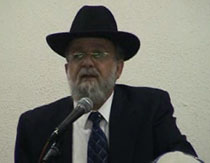Beit Midrash
- Sections
- Chemdat Yamim
- P'ninat Mishpat
- Family and Society
- Financial Laws and Tzedaka
- Neighbors and Partners
[This responsum is uncharacteristically low on halachic sources and its final recommendation seems to be based more on "common sense" than on rigorous halachic analysis. It is telling that it concludes as follows: "This is what appears to my humble opinion without looking at books."]
Case: Reuven and Shimon had adjacent houses on identical properties, but Reuven’s house extended beyond Shimon’s because Shimon had insufficient money for further construction. 35 years ago, Reuven’s house burned down, and when he rebuilt it according to its previous size, he built a large window facing the empty section of Shimon’s property. 20 years later, Reuven died, and recently Reuven’s inheritors sold the property to Ephrayim Shmuel. Many years ago, Shimon died, and Shimon’s inheritors subsequently sold it to Moshe Elazar. Moshe Elazar extended the house to the length of Ephrayim Shmuel’s and left four amot space in front of the latter’s window. Now, Moshe Elazar is demanding of Ephrayim Shmuel to seal up the window, claiming that Reuven built it without authorization. Witnesses state that there was no window prior to the fire. One witness says that Shimon took Reuven to beit din over this, and beit din ruled that he had no right to such a window. It is not known if subsequently the two compromised, Reuven paid Shimon for rights, or Shimon relinquished his claim. Ephrayim Shmuel says that since he bought the house with the window from the inheritors, beit din should extend claims they could have made for the inheritors to him as their successor.
Ruling: If Moshe Elazar, the plaintiff, had not brought a witness about a din Torah regarding the window, we would have said that Shimon had not complained because he was unaware of his right to do so at a time when he had not built on that section of the property. Although the Netivot Hamishpat states that one can always protest about a permanent window, Shimon may have been unaware of that halacha. (See Tosafot, Bava Metzia 16, who says that it is sufficient for there to be one opinion holding a different way in order for a litigant to say that he was unaware of the halacha.)
Although we would not have initiated this line of defense if Shimon were alive, we would have raised it on behalf of his inheritors, as they are likely to have been unaware of what transpired. If so, Reuven’s side would not have had a chazaka on the use of the window. The fact that Moshe Elazar kept his building four amot away from the window could have been because he did not know the halacha, as opposed to relinquishing his rights. Even though a witness said that there had been a din Torah on the matter, we could say that the din Torah had ruled that he had to close the window, but Shimon had just not succeeded in having it enforced.
Why don’t we say that we make the claim on behalf of Reuven’s successors that he got Shimon to agree to the window? Since one witness says that there was a din Torah whose ruling went against Shimon, even though one witness does not suffice, it still strengthens Shimon’s side enough to give the advantage to his successors over Reuven’s. Had Reuven elicited a concession from Shimon, he should have received confirmation in writing. Although one does not usually guard documents for more than three years, after a din Torah, he should have kept it. In any case, the claims of those who bought from Shimon’s family are stronger, and the window should be sealed.

P'ninat Mishpat (806)
Various Rabbis
335 - Subletting a House to a Larger Family
336 - Can the Old Window Stay?
337 - Sanctions Against Overchargers Against the Rabbi’s Will
Load More

P'ninat Mishpat: Smoking Rights in a Rental? – part I
based on ruling 85076 of the Eretz Hemdah-Gazit Rabbinical Courts
Beit Din Eretz Hemda - Gazit | Tishrei 5786

P'ninat Mishpat: Smoking Rights in a Rental? – part II
based on ruling 85076 of the Eretz Hemdah-Gazit Rabbinical Courts
Beit Din Eretz Hemda - Gazit | Tishrei 5786

P'ninat Mishpat: Rental of an Apartment that Was Not Quite Ready – part II
based on ruling 82031 of the Eretz Hemdah-Gazit Rabbinical Courts
Beit Din Eretz Hemda - Gazit | Iyar 5784






















